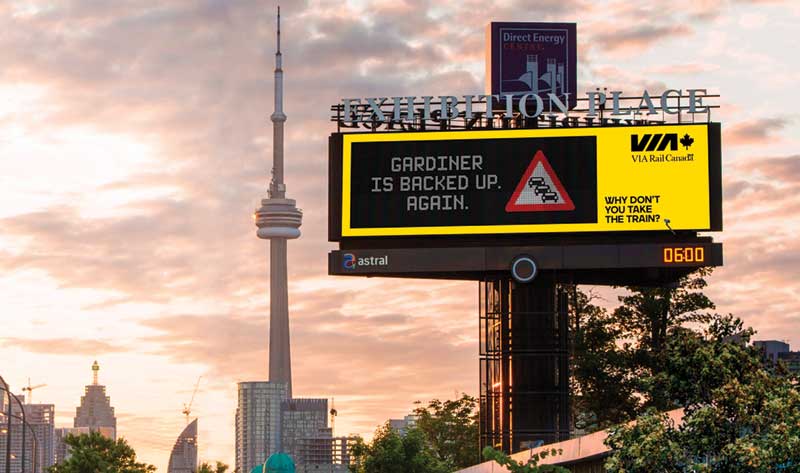By Rosanne Caron
In 2016, online media accounted for 47 per cent of all Canadian advertising revenues. Most other paid media have experienced a decline in their ad revenues due to the overall shift toward online spending. One notable exception, however, is out-of-home (OOH) advertising, which has continued to experience at least modest growth year-over-year.
Consultations with industry stakeholders, including advertisers, agencies and OOH network operators, suggest there are two key barriers preventing OOH from significantly increasing its share of total ad revenue. Both of these barriers will need to be addressed.
First, the OOH industry needs to be able to provide both quantitative and qualitative information about its audience. The current numbers being reported are not enough. Agencies and advertisers need further ‘proof’ of and actionable insight into the particular consumer demographics being delivered to them, along with the associated lifestyles
and behaviours, if they are to justify greater expenditures on OOH ads. Granular data at the location-specific level will provide this assurance, showing how advertisers’ messages are reaching the desired audience at the right place and time.
Secondly, the planning and buying process for OOH campaigns needs to be made easier and more efficient, so the medium as a whole becomes more attractive to advertisers. If OOH is instead seen as a ‘resource hog’ that takes more time than other media to plan, then this will negatively affect the industry’s efforts to increase its share of ad revenue.
The Canadian OOH Measurement Bureau (COMB), which publishes OOH market data, has been working closely with its member companies to address these barriers. Fortunately, there have been some exciting developments and there are new changes on the horizon.
Celebrating great campaigns
Given the rise of online advertising, it may seem ironic how a campaign for Twitter, a social media platform, was the Grand Prix winner at the 2017 Cannes Lions International Festival of Creativity in the outdoor advertising category. Twitter’s use of simple and engaging OOH content, featuring its logo and hashtags alongside images from the news and pop culture, highlighted its ability to provide a forum for political debate and discussion of issues ranging from guns to marijuana.
It is interesting to note the similarities between Twitter and OOH media. The social media platform restricts the length of messages, forcing it users’ ‘tweets’ to be succinct and focused, rather than allowing a long, drawn-out dialogue. Creating an effective message for a billboard that is only seen for a few seconds also requires a certain singlemindedness, which Twitter understood with its award-winning campaign.
“OOH is a great way to get people to look up,” says Jayanta Jenkins, Twitter’s global creative chief. “You can use less to say more.”

A campaign for Twitter was the Grand Prix winner at the 2017 Cannes Lions International Festival of Creativity in the outdoor advertising category.
In early 2017, the OOH Marketing Association of Canada (OMAC) launched the Iris Awards as a new way to acknowledge outstanding campaigns created by Canadian agencies. For the first quarter (Q1), the winners were Warner Bros. Direct’s The Lego Batman Movie campaign—which spanned subway train wraps, station murals, digital OOH (DOOH) content and experiential stunts—and the second phase of Sid Lee’s ‘street swatch’ digital transit shelter campaign for Réno-Dépôt. The second quarter (Q2) winners were CloudRaker’s Kijiji Auto Search billboards, which targeted commuters in specific neighbourhoods based on demographic data mapping, and Lg2’s ‘mind-reading’ digital transit shelter ad promoting the Festival de Magie de Quebec.
What makes the Iris Awards unique from other programs is the judging of quarterly entrants has been handled by a panel of consumers, based on visual impact and appeal, message comprehension and relevance, which will determine 2017’s grand prize winner. The creative team behind the top campaign will be OMAC’s guests at the Outdoor Advertising Association of America’s (OAAA’s) 2018 Obie Awards event in Austin, Texas. The Obies are among the oldest and most prestigious honours for OOH advertising.
OMAC also helped launch Open3, a new book celebrating creativity in OOH advertising, in the spring and is currently distributing 1,000 copies to marketers and creative agencies across Canada to help showcase the creative potential of OOH campaigns. (It can also be viewed online at www.omaccanada.ca/open3.)
To develop Open3, OMAC collaborated with some of its counterparts around the world, including OAAA, the Outdoor Media Association of Australia (OMA), Outsmart UK and the Federation European Publicité Exterieur (FEPE). Together, they compiled more than 150 images of some of the world’s best OOH campaigns, including 16 projects from Canada, along with essays contributed by industry leaders, including Zak Mroueh, founder, CEO and chief creative officer of Toronto-based agency Zulu Alpha Kilo.
“OOH is one of the oldest forms of media, yet few know how to capitalize on its attention-getting power,” says Mroueh. “Open3 will hopefully inspire the next generation of creative OOH thinkers.”
“There’s never been a better time to be creative, to be a game-changer and to reinvent the OOH industry,” adds Philippe Meunier, co-founder and chief creative officer of Sid Lee.
OMAC’s own library includes more than 100 case studies from around the world and across various business sectors that demonstrate the value of OOH in effective communications for audiences on the move. Many of the recent examples show how OOH’s role has been redefined, from building scale and reach to inspiring mobile searches and purchases, among other activities. The searchable library can be found at www.omaccanada.ca/case-studies.






